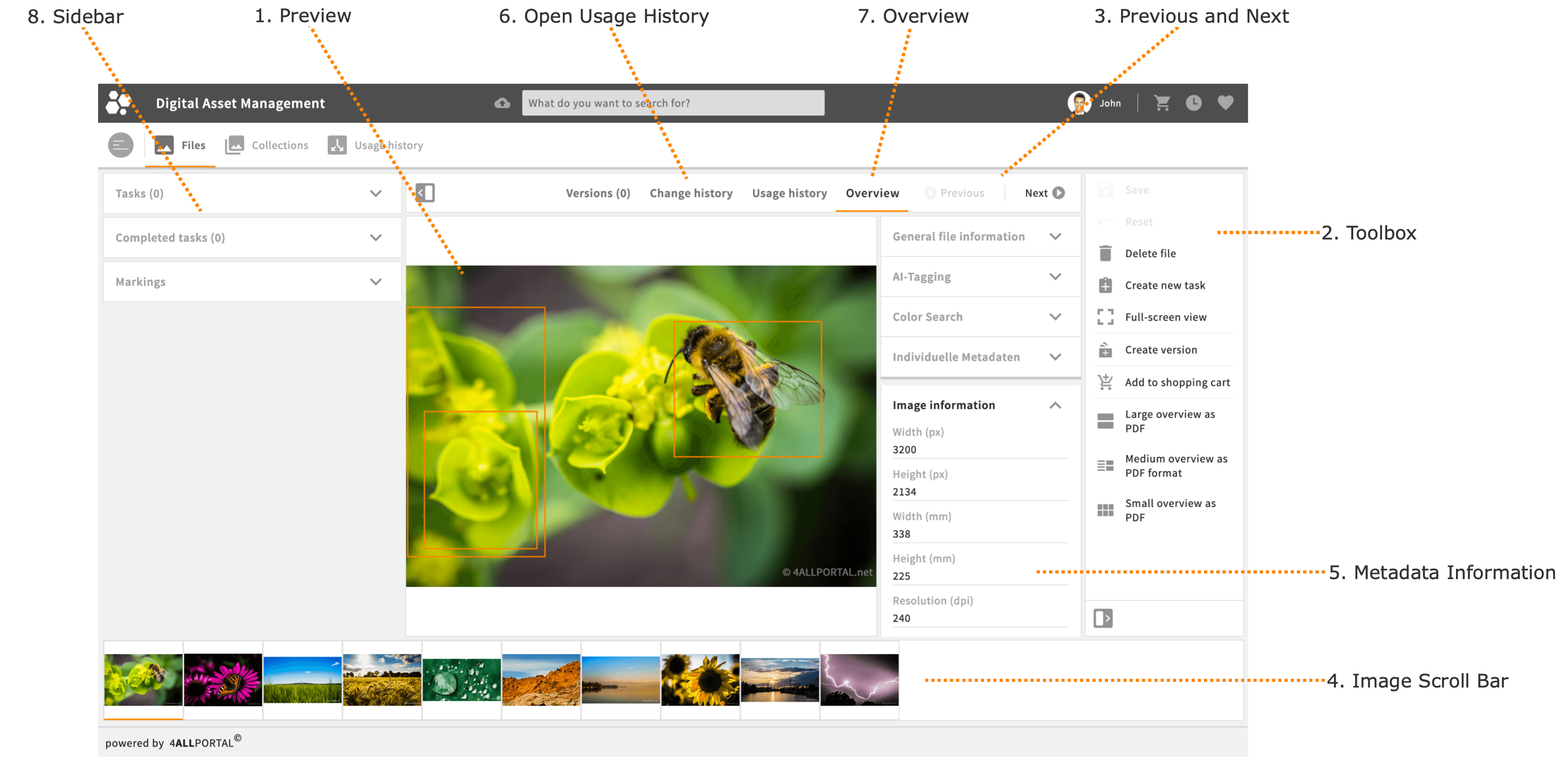Detail View – Files / Manage Files
The detail view represents the contents of a file. It consists of two sub-views: one that displays a preview, and another that displays the metadata and usage history of a file. Via the detail view, you can create, edit, and delete metadata based on your available user permissions.
Notes: The preview screen in 4ALLPORTAL displays the files as images to provide helpful visual orientation.
Please note that only previews of the original files generated by the system will be displayed. You will not see the file contents in the original, merely in preview quality. For unknown file formats or corrupt data/files where a visual preview cannot be generated, a file icon will be shown in place of the preview.
We use customary, standard tools for generating the previews.
Please understand that, due to technological restrictions, previews will necessarily look somewhat different from the original file.
Viewing behavior: When you close and open the view again within a single user session, the detail view will remember the last sub-view you had open.

1. Preview
Displays a preview of a file.
Please note the information provided above.
The preview area can display images and graphics, play video and audio, and allow you to page through documents.
Depending on the file type (image, video, document), a range of different viewing functions will be available to you in the preview area.
1.1 Preview for Images/Graphics
Hover your cursor over the upper edge of a preview image to display a control element with zoom functions.
Click the plus (+) or minus (-) button to zoom in or out.
Clicking the frame icon multiple times will set the image/graphic to the maximum window height or width.

1.2 Representation of Transparency
If images have a transparent background or an alpha channel to produce transparency, we can now reproduce this in the preview area, as well as in all other preview components, via a checkered pattern behind the image motif.
Transparency is depicted for the following formats:
Photoshop PSD and PSB
PNG
TIFF (only with alpha channel)

Example: Depiction of transparency for formats TIFF, PSD, PSB, and PNG in the tile view
1.3 Preview for Documents:
When you open a document in the detail view, a control element with zoom and paging functions will be displayed.
Click the plus (+) or minus (-) button to zoom in or out.
Clicking the frame icon multiple times will set the document to the maximum window height or width.
After clicking on the page number display, you can enter a page number to go directly to that page. Alternatively, you can hover your cursor within the preview area and scroll down and up with the mouse wheel to page forwards and backwards.

Note: The page display applies to the pages in a document that are technologically available. The page display has no relation to page numbers in the page layout.
1.4 Preview for Audio and Video
When you open an audio or video file in the detail view, a control element that allows you to navigate the playback will be displayed.
Video content is displayed as a preview collage. For audio files in MP3 format, an album cover will be displayed, if available in the file.
You can use the control elements to launch the preview playback of the media in question.
Note: The display and playback options in the control element may vary for different audio and video formats.
Different options may also be offered depending on the browser used. This is because the audio or video player used in the preview is provided by your browser, and not by 4ALLPORTAL.
If you have playback issues, please first check whether the problem might be caused by your browser by testing the playback in another browser or on another computer.

2. Toolbox
The toolbox displays the actions available in the detail view for the file you have opened.
For example, you can delete the file or open it in full-screen view.
Note: Toolbox functions are usually customized for your organization. The options and functions available to you depend on your user permissions. Another user may be able to use options that you cannot use as a result of your restricted user permissions.
3. Previous and Next
A click on the “Previous” or “Next” icon changes the display to the previous or next file shown in the image scroll bar.
4. Image Scroll Bar
Displays further objects from your selection or the search results from the main view.
Click a thumbnail to open the detail view of the selected object. You can only select one object at a time.
If there is a large number of objects displayed, you can hover the cursor over the image scroll bar and use your mouse wheel to scroll through the images.
Alternatively, arrow icons that allow you to scroll through the images will be displayed to the left and right of the image scroll bar.
5. Metadata Information
Displays metadata of files.
You can create, edit, and delete metadata based on your available user permissions.
You can find further information in sub-chapter Metadata .
6. Open Usage History
Click the “Usage history” button to open this sub-view.
You can find further information in sub-chapter Usage History.
7. Open Overview
Click the “Overview” button to open this sub-view.
You can find further information in subchapter Metadata.
8. Side Bar
The side bar can display different groups of modules and functions.
Tasks
By default, the sidebar will show entries for a file from the Tasks module, whatever the file type. These are subdivided into groups “Tasks” (status “Open”) and “Completed tasks” (status “Completed”).
You can find further information in chapter “Tasks Module”.
Linked files
For the files types associated with the applications InDesign (.indd, .idml) and PowerPoint (.pptx, .ppt, .pptm, .potm, .pot, .potx), the side bar will show the groups “Linked files” and “Linked with”.
You can find further information in subchapter“Linked Files”.